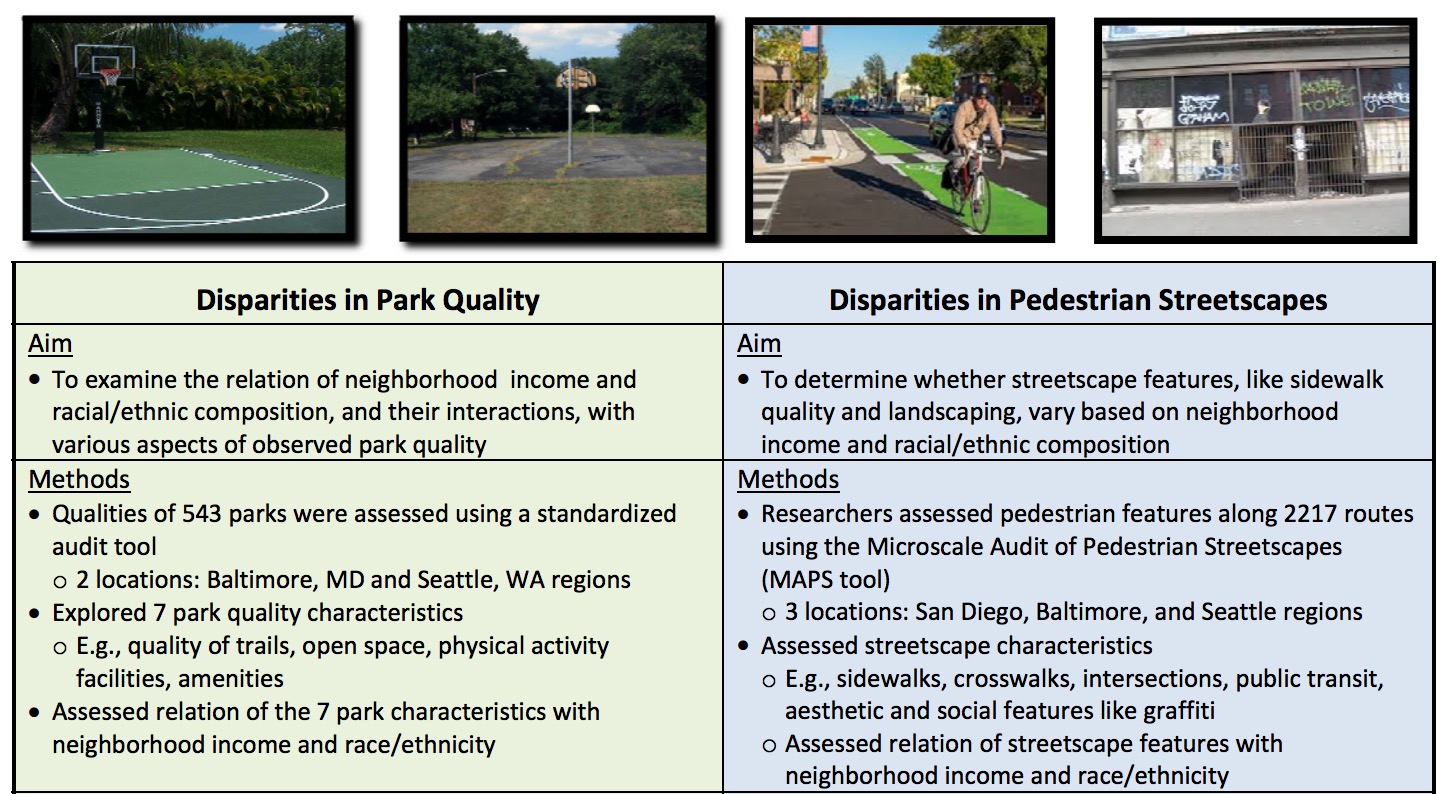ACTIVE LIVING RESEARCH
UNIVERSITY OF CALIFORNIA, SAN DIEGO
Two new studies shed light on how to make neighborhoods more physical activity‐friendly for all people, regardless of income or race
Key findings:
- Sometimes parks and streetscapes were higher quality in low‐income or high‐minority areas
- Patterns of disparities varied by region, so local data are needed
Introduction
Low‐income and minority populations suffer disproportionately high rates of chronic disease. Accordingly, national and international authorities have made the elimination of health disparities a priority. Many factors can contribute to health disparities, including disparities in the quality of neighborhood environments. For example, having a neighborhood park and pedestrian‐friendly streets may impact opportunities to engage in physical activity – a behavior that can reduce risk of chronic disease.
Research on how neighborhood environments relate to physical activity has typically focused on overall community design, like the number of intersections or distance to the nearest park. Most studies have not evaluated community features in greater detail, like whether parks had physical activity facilities, or if intersections had safe, marked crosswalks. To address this research gap and improve our understanding of health disparities, two recent publications examined whether park quality and pedestrian streetscapes varied based on neighborhood income or racial/ethnic composition. As compared to changing overall community design, such as the layout of roads, improving the quality of parks and pedestrian streetscapes may provide a more feasible and affordable approach to creating activity‐friendly environments.
Both studies found evidence of disparities, where physical activity environments were less favorable in low‐income and high‐minority neighborhoods. Surprisingly, both studies also found evidence of “equitable differences” – instances where park quality and streetscape features were better in low‐income and high‐ minority neighborhoods. The results of these studies provide important information for local policy makers, planners, and community groups interested in making targeted changes to increase physical activity opportunities for all residents.
…
Conclusions & Recommendations
- Park and streetscape features are changeable and offer a feasible and affordable approach to creating activity‐friendly environments.
- Both studies found evidence of “disparities” (pedestrian features that were worse in low‐ income and/or high‐minority neighborhoods) and “equitable differences” (pedestrian features that were worse in high‐income and/or mostly White neighborhoods).
- The park and streetscape features that exhibited disparities varied greatly between regions.
- The different patterns found across regions suggest that local policies, practices, and funding priorities can be effective. Disparities in physical activity environments are not inevitable. They are due to local decision-making.
- Given the differences found between regions, local audits are recommended to evaluate differences between neighborhoods and determine how to best allocate resources.
- Information from audits can help local policy makers, planners, and community groups to identify disparities, make targeted changes, and increase physical activity opportunities for all residents, regardless of race, ethnicity, or income.
- Community groups are encouraged to work with government agencies to document quality of physical activity environments in their neighborhoods and use local data to develop plans for improvement.
Download full version (PDF): Disparities in Park Quality and Pedestrian Streetscape Environments
About Active Living Research
activelivingresearch.org
Since 2001, ALR has been at the forefront of building evidence on how to create communities that increase opportunities for physical activity. We have learned that communities designed for activity are better for health, economic vitality, and environmental sustainability.
Tags: Active Living Research, ALR, Baltimore, CA, California, Maryland, MD, Pedestrian, San Diego, University of California San Diego, Walkability







 RSS Feed
RSS Feed